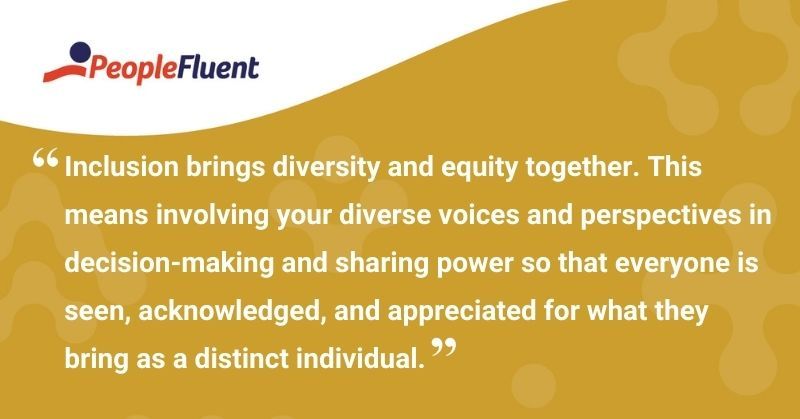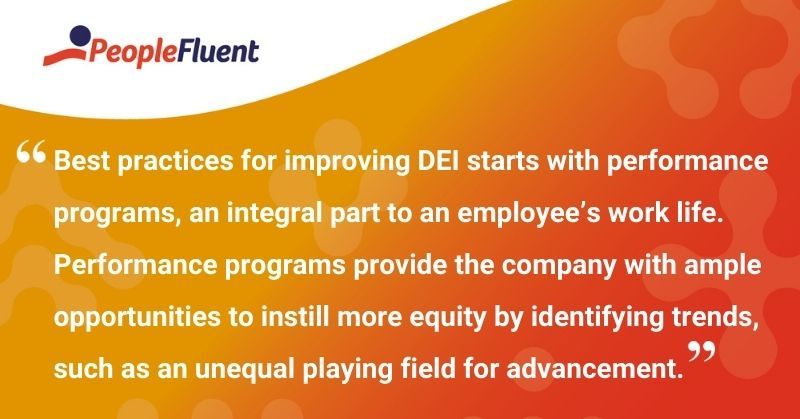Published: Mar 12, 2021Time to read: 7mins Category: Insights
4 Key Components of Building a Data-Driven DEI Strategy
As business leaders are engaging in different conversations about diversity, equity and inclusivity, organizations are now looking to their HR teams to guide them through a strategic approach. In this article, we recap our conversation with ReadySet about building more equitable and inclusive people programs.
What’s New With DEI?
Based on an internal survey of 500 U.S. HR professionals and business leaders, more than 90% of companies said they’re making DEI a priority. For comparison, in 2017, only 69% were focusing on DEI and just 59% in 2014.
Some of the highest priority DEI initiatives right now are:
- Improving workplace culture to foster belonging and inclusivity
- Ensuring advancement opportunities for employees from underrepresented groups
- Improving employee sentiment on inclusion
HR professionals and business leaders understand the importance of DEI and are now taking actionable steps to make this part of a holistic business strategy. Before diving into the next steps of developing a DEI strategy at your organization, let’s break down the acronym:
Diversity
Diversity of perspective can come from many channels, but the best way to achieve it is by incorporating different voices within teams and across the company. These differences exist as race, ethnicity, sexual orientation, gender, religion, age, disability, socioeconomic status, language, and geographical area.
Equity
Equity is acknowledging that the playing field has not been, or is not, level for everyone. Creating an equitable organization relies on providing employees with the right support so that they (and candidates) have equal employment opportunities regardless of differences.
Inclusion
Inclusion brings diversity and equity together. This means involving your diverse voices and perspectives in decision-making and sharing power so that everyone is seen, acknowledged, and appreciated for what they bring as a distinct individual.

KEEP READING | 'The Three Cs: Talent Management Strategies to Engage Your Multi-Generational Workforce'
5 Ways to Create an Inclusive Company Culture
There are several ways for leaders to address biases and instill equity at their organizations. One way is to create an inclusive culture where employees feel comfortable to raise issues and work together in an effort to overcome them. Here are five focus areas:
1) Recruiting and Outreach
A candidate’s first impression will be made during the recruitment process so it’s important to create a winning candidate experience. You can start by ensuring that your job descriptions are accessible to all candidates. This means removing gendered language such as ‘dominant’, ‘competitive’, ‘outspoken’, or ‘rock star’—traditionally considered to be masculine words that make women less likely to apply for the job.
Another way to remove biases is to define criteria for the posted role and ensure that all candidates receive the same questions during an interview. Additionally, be thoughtful about the salary negotiation process as it historically rewards candidates who’ve honed their negotiating skills versus those who haven’t.
2) Employee Onboarding and Education
After employees are part of the organization, it’s time to focus on creating an inclusive and educational onboarding experience. Provide a welcome packet that introduces key team members and provides a sense of the company’s rituals. If there are forums for people to learn about one another or Employee Resource Groups (ERGs), note this in the packet.
Include opportunities for new employees to give feedback early in the onboarding process. HR can guide managers on how to start conversations, with questions like “what’s one unexpected thing you learned last week?” This gives the employee a chance to open up and allows the line manager to pinpoint possible issues in the onboarding process.
RELATED READING | '4 Best Practices for Your Onboarding Checklist'
3) Employee Resource Groups
ERGs provide an excellent forum for employees to gather and discuss top-of-mind issues, even if the groups start off simply filling a social purpose. Overall, it’s recommended that HR teams discuss and get aligned on the purpose of offering ERGs. Done right, ERGs can be great for building community and culture as well as a pipeline for leadership development.
4) Communication and Transparency
Companies can (and should) improve communication and visibility in an effort to create a sense of belonging and equity for all employees. Organization-wide meetings, like all-hands, can help here but it’s also important to allow employees to share anonymous feedback—pulse surveys are a great tool for doing so. If there’s a decision that can’t be discussed widely, be sure there’s another way for communication to happen so the process can move forward in a fair way.

RECOMMENDED RESOURCE TO DOWNLOAD | 'The Modern Talent Journey: Charting the New Ways of Work'
5) Leadership and Management
For most employees, their manager will have a significant impact on their work experience—and how they experience the company culture. Managers should be equipped to have productive conversations where feedback is welcome and there’s a clear focus on the team’s success as a whole.
Managers can better understand an individual’s motivators by diving deeper into the employee’s strengths and gaps. Then, in concert with HR, they can offer ways to leverage strengths (e.g. stretch projects) and/or work on developing new skills to help build employee confidence.
Take a Data-Driven Approach to DEI Strategy
Putting all of the above into practice begins with understanding the four key components of a data-driven DEI strategy. This is done by:
1) Conducting a company-wide DEI engagement survey. This gives employees a chance to say what’s working and what isn’t. Organizations then have valuable data that can be analyzed, giving HR teams the ability to perform a DEI audit. HR can then focus its efforts on addressing areas of underperformance.
A DEI audit provides another set of metrics for assessing equity, especially when HR teams evaluate pay, promotions, leader representation, and manager representation. In addition to hiring and starting salary statistics, consider evaluating retention and promotion statistics too.
2) Hosting employee focus groups. In an effort to dig deeper into employee sentiment around DEI, we recommend hosting employee focus groups after the engagement survey. This provides context and visibility into areas that the survey data might have missed. For instance, the survey may show you that LGBTQIA groups don’t feel the same sense of belonging as other groups. Focus groups can help you understand what’s causing this sentiment as well as ideas on how to address this gap.
3) Gathering employee data. While engagement surveys and audits provide helpful information, they might not include all of the data you’re looking for. For instance, employees may decide not to provide information on gender or sexual orientation, which makes it a challenge to address employee sentiment. Instead, HR teams can view data by location or other employee demographics
4) Analyzing data for trends and intersectionality. Through trend analysis, HR teams can identify patterns—like more women in management positions—that may give them a sense of where current opportunities are. Here’s where data intersectionality, (when an individual has two or more attributes that can compound the discrimination they experience), comes in.
For example, you can look at trends for women or people of color versus women of color who hold certain positions. Consider if the latter cohort is more likely to advance in their roles as men of color are. Data intersectionality enables HR to grasp the wider employee experience for individuals who are underrepresented in multiple ways.
YOU MIGHT ALSO LIKE | '5 Things HR Pros Can Do to Ensure a Modern Talent Journey'
Make Your Performance Programs Equitable
Now that you have data sources and best practices for how to use that data, identify key areas of opportunity at your company and how you can act on this data. Best practices for improving DEI start with performance programs, an integral part of an employee’s work life. Data from performance programs can be used to identify DEI opportunities at your company, such as instilling more equity in the review process.
With more equal and inclusive performance processes, you can drive productive employee-manager conversations, valuable feedback, and objective performance assessments.
